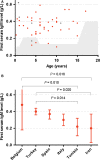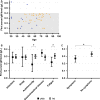Challenges in investigating patients with isolated decreased serum IgM: The SIMcal study
- PMID: 30887554
- PMCID: PMC6850338
- DOI: 10.1111/sji.12763
Challenges in investigating patients with isolated decreased serum IgM: The SIMcal study
Abstract
The clinical consequences of isolated decreased serum immunoglobulin (Ig)M are not sufficiently known. Therefore, it is difficult to determine the clinical policy following such a finding. Only few reported IgM-deficient patients fulfil the European Society for Immunodeficiencies (ESID) diagnostic criteria for selective IgM deficiency (true sIgMdef), or their diagnosis is uncertain due to insufficient laboratory data (possible sIgMdef). Decreased serum IgM is often incidentally found in asymptomatic adults. The objective of our study was to further characterize true sIgMdef and to compare the European data collected through the ESID Registry community (tertiary centres) to our previously published Dutch cohort (secondary centre). Fifteen centres (12 countries) participated with 98 patients. Patients were excluded if serum IgM was only determined once (n = 14), had normalized (n = 8), or if they also had other immunological abnormalities (n = 15). Ten patients (5 adults) completely fulfilled the ESID criteria for true sIgMdef. Age-matched cut-off values varied widely between centres; when using the ESID diagnostic protocol reference values, only six patients (five adults) had true sIgMdef. Because of these small numbers, further analyses were performed in patients with true or possible sIgMdef (13 adults, 48 children). Respiratory infections were commonly reported at presentation (adults 54%, children 60%). Symptomatic adults had lower serum IgM levels (mean 0.27 g/L, 95% CI 0.22-0.31) than those without symptoms (mean 0.33 g/L, 95% CI 0.30-0.36; P = 0.02). To be able to explore the clinical consequences of true sIgMdef, we should fully analyse and accurately describe those patients in whom a decreased serum IgM is found.
Keywords: primary immunodeficiency; primary selective IgM deficiency; unclassified antibody deficiency.
© 2019 The Authors. Scandinavian Journal of Immunology published by John Wiley & Sons Ltd on behalf of The Foundation for the Scandinavian Journal of Immunology.
Conflict of interest statement
The auths declare that they have no conflict of interest relative to this project.
Figures





Similar articles
-
Truly selective primary IgM deficiency is probably very rare.Clin Exp Immunol. 2018 Feb;191(2):203-211. doi: 10.1111/cei.13065. Epub 2017 Oct 27. Clin Exp Immunol. 2018. PMID: 28984901 Free PMC article. Review.
-
Down syndrome B-lymphocyte subpopulations, intrinsic defect or decreased T-lymphocyte help.Pediatr Res. 2010 May;67(5):563-9. doi: 10.1203/PDR.0b013e3181d4ecc1. Pediatr Res. 2010. PMID: 20098344
-
Comparative efficacy of leniolisib (CDZ173) versus standard of care on rates of respiratory tract infection and serum immunoglobulin M (IgM) levels among individuals with activated phosphoinositide 3-kinase delta (PI3Kδ) syndrome (APDS): an externally controlled study.Clin Exp Immunol. 2025 Jan 21;219(1):uxae107. doi: 10.1093/cei/uxae107. Clin Exp Immunol. 2025. PMID: 39673396 Free PMC article.
-
The outcome of patients with unclassified hypogammaglobulinemia in early childhood.Pediatr Allergy Immunol. 2009 Nov;20(7):693-8. doi: 10.1111/j.1399-3038.2008.00845.x. Epub 2009 Jan 31. Pediatr Allergy Immunol. 2009. PMID: 19196447
-
Selective IgM Deficiency: Clinical and Laboratory Features of 17 Patients and a Review of the Literature.J Clin Immunol. 2017 Aug;37(6):559-574. doi: 10.1007/s10875-017-0420-8. Epub 2017 Jul 21. J Clin Immunol. 2017. PMID: 28730517 Review.
Cited by
-
The epidemiology and clinical features of selective immunoglobulin M deficiency: A single-center study in China.J Clin Lab Anal. 2020 Jul;34(7):e23289. doi: 10.1002/jcla.23289. Epub 2020 Mar 10. J Clin Lab Anal. 2020. PMID: 32157736 Free PMC article.
-
Neurolisteriosis in a previously asymptomatic patient with serum IgM deficiency: a case report.BMC Neurol. 2020 Aug 31;20(1):323. doi: 10.1186/s12883-020-01900-3. BMC Neurol. 2020. PMID: 32867717 Free PMC article.
-
Selective IgM Deficiency: Evidence, Controversies, and Gaps.Diagnostics (Basel). 2023 Sep 4;13(17):2861. doi: 10.3390/diagnostics13172861. Diagnostics (Basel). 2023. PMID: 37685399 Free PMC article. Review.
-
Defining Primary Selective IgM Deficiency.J Clin Immunol. 2019 May;39(4):350-352. doi: 10.1007/s10875-019-00641-4. Epub 2019 May 9. J Clin Immunol. 2019. PMID: 31073845 No abstract available.
References
-
- Louis AG, Gupta S. Primary selective IgM deficiency: an ignored immunodeficiency. Clin Rev Allergy Immunol. 2014;46(2):104‐111. - PubMed
-
- Entezari N, Adab Z, Zeydi M, et al. The prevalence of Selective Immunoglobulin M Deficiency (SIgMD) in Iranian volunteer blood donors. Hum Immunol. 2016;77(1):7‐11. - PubMed
-
- Guill MF, Brown DA, Ochs HD, Pyun KH, Moffitt JE. IgM deficiency: clinical spectrum and immunologic assessment. Ann Allergy. 1989;62(6):547‐552. - PubMed
-
- Cipe FE, Dogu F, Guloglu D, et al. B‐cell subsets in patients with transient hypogammaglobulinemia of infancy, partial IgA deficiency, and selective IgM deficiency. J Investig Allergol Clin Immunol. 2013;23(2):94‐100. - PubMed
Publication types
MeSH terms
Substances
LinkOut - more resources
Full Text Sources

